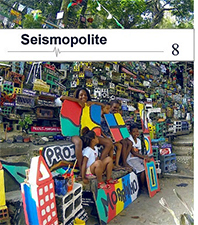Dec.10, 2014
Editorial
(Re-)emerging territories of expression
As variously situated as these articles and their cases are, they all have in common the presentation of territories of expression which (re-)emerge – from forgetfulness, from calculated oppression, from a set of historical and/ or natural coincidences, or a combination of all of these. The latter notably seems to be the case in indigenous eco-theatre, as discussed in an article by Melissa Campbell. Here, nature reemerges through indigenous playwrights' simultaneous concerns for emancipation and for climate change – legitimized by the "double oppression" represented by the environmental crises and the political situation of many indigenous peoples.
On another scene, Kiril Avramov's article on political grafitti and artistic intervention addresses the political stage of Bulgarian post-socialism, in which the urban landscape unavoidably reasserts its status as the canvas of protest and transformation, due to public and private mass media's "selective blindness" to dissenting views. The logic of authoritarian rule and oppression is also the theme of Basma Hamdy's article on the current situation in Egypt, with all-encompassing yet unpredictable "administration of fear" and political control by the state – also, and not least over image production. And yet, as she emphasizes:
Despite the arrests, jail terms and human rights violations, opposition voices are still strong and resilient. Artists, writers, journalists and musicians continue to produce work that challenges the regime and its followers.
In an article discussing three larger, recent exhibitions of Southeast Asian contestative art, Bharti Lalwani observes these recurrent and powerful characteristics of a contemporary and specifically "regional canon": it is "formally appealing, interactive, audience involving, borrowing codes from millennia-old culture materially and conceptually, performative, tactile, playful yet contestative." Lalwani demonstrates how artists often co-opt the public to make them responsible for and involved in a questioning of politics and national history, but also how their artistic strategies can be translated to audiences all over the world.
Discussing the emerging art scene in Pakistan, Fatima and Zahra Hussain depart from a similar interest, but land in a paradox to which they also dedicate their practice:
(...) art at home fails to create (as opposed to entertain) a local audience for itself (...) At the same time, some major [political] events have majorly dictated the emergence of creative practice (...) [and] curated the socio-spatial landscapes of urban environments and the development of the creative faculties within these.
Last, but not least, a very strikingly literal example of a re-emerging territory of expression, is found in Luisa Santos' article about the art project Projeto Morrinho of the Favela do Pereirão in Rio de Janeiro, in which the original authors were a 14 year-old boy and his comrades. Together they created a miniature model of their favela which not only became a travelling art exhibition, a documentary film and the basis for a more sustainable socio-economic development of their community, but also a powerful contribution to a gradual redefinition of the very term favela – which, for more than a century, has been condescendingly defined by outsiders.
Front cover image courtesy of Projecto Morrinho, all rights reserved.









